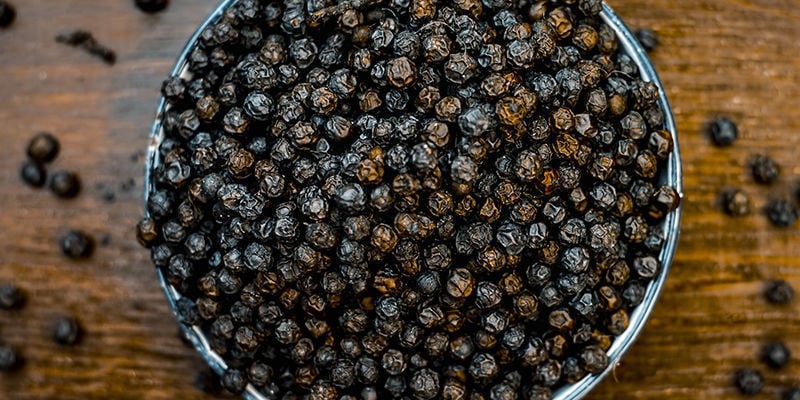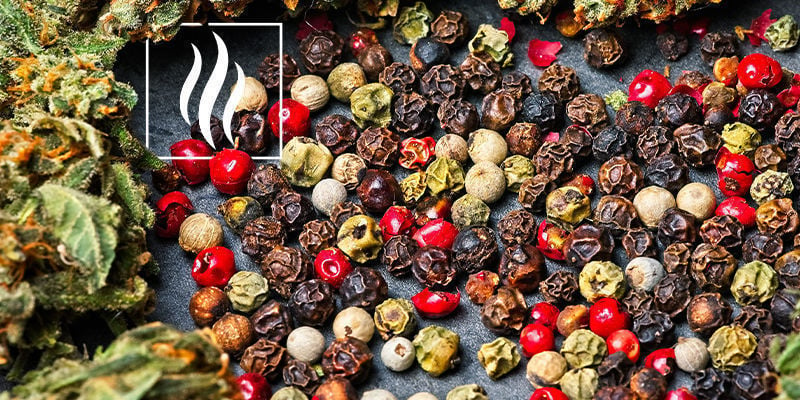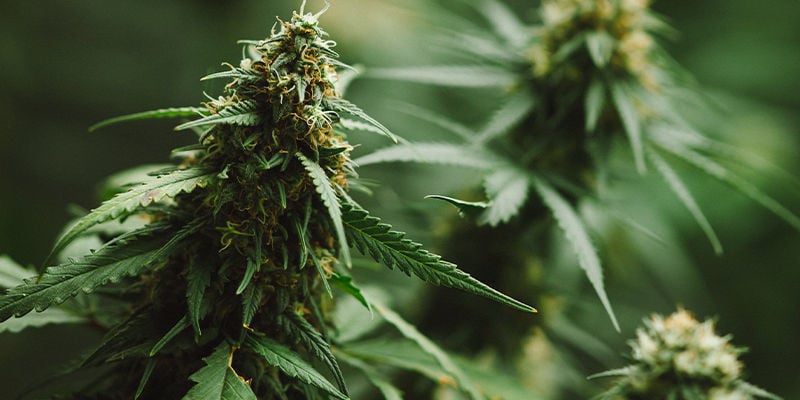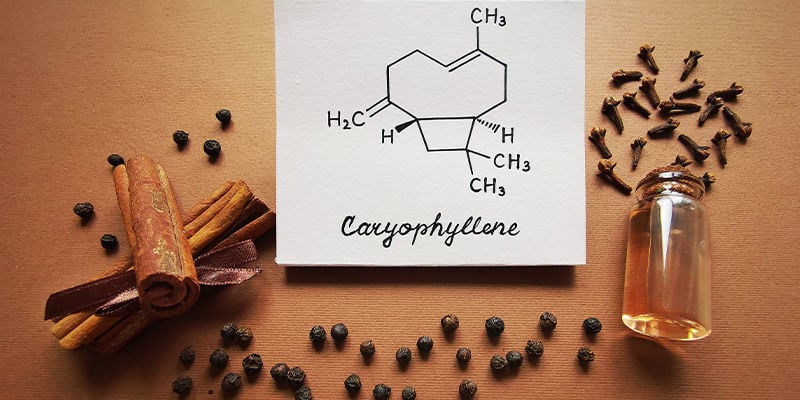
What Is Caryophyllene In Cannabis?
Caryophyllene is a cannabis terpene with a spicy aroma reminiscent of black pepper. But how does caryophyllene support the aromas and effects of cannabis? Scroll down to find out more about this prominent cannabis constituent.
Notice a unique spicy or peppery kick in the aroma seeping from your curing jars? Chances are you're picking up on the unique scent of caryophyllene, a cannabis terpene renowned for its warmth and spice. Read on for a closer look at caryophyllene, one of the most common terpenes in modern cannabis strains.
What is caryophyllene?

Caryophyllene (or beta-caryophyllene) is a bicyclic sesquiterpene present in cannabis and many other natural substances, such as plants and spices. In cannabis, it is one of the most prominent terpenes, making up between 3.8–37.5% of the essential oil of cannabis flowers (Mediavilla & Steinemann, 1997). Besides contributing strongly to cannabis' unique aroma, caryophyllene is also the only terpene known to bind directly to cannabinoid receptors, and may thereby play an important role in cannabis' effects on the body.
Interestingly, caryophyllene is also thought to affect the sensory receptors of certain insect pests, diminishing their ability to successfully devour plant matter on living cannabis plants.
Smell and aroma of caryophyllene

Caryophyllene has a spicy aroma, and is in fact one of the main contributors to the smell of black pepper. It is also present in herbs and aromatic spices (listed below), where it imparts a warm, spicy, peppery kick. Think of the subtle hint of spice you might detect in the smell of certain hoppy beers, in freshly picked basil or rosemary, or crushed black pepper, caraway, or cloves.
Where can you find caryophyllene?
Caryophyllene is present in many plants and their essential oils. Some common natural sources of caryophyllene include:
- Cannabis
- Basil
- Rosemary
- Oregano
- Hops
- Lavender
- Black pepper
- Cloves
- Caraway
- Cinnamon and malabathrum
- Ylang ylang
- Copaiba oil
Caryophyllene is also commonly used to prepare perfumes, aromatic and essential oils used in aromatherapy, and spice blends made using the herbs and spices listed above. It is also a common ingredient in cosmetics and processed foods.
What is the chemical structure of caryophyllene?
Caryophyllene has a complex chemical structure. It is a large molecule, with a much larger molecular mass than other common cannabis terpenes. Caryophyllene also has a cyclobutane ring, which is very unusual in terpenes and natural compounds in general, as well as two double bonds.
Besides its high molecular mass and unique structure, caryophyllene also has the peculiarity of having a high affinity for cannabinoid receptor 2 (CB2). In fact, caryophyllene has a much higher affinity for CB2 than cannabinoids such as THC and CBN. By binding to CB2 receptors, research suggests that caryophyllene may have clinical potential (see below) without producing the high associated with THC.
Potential benefits of caryophyllene

Caryophyllene is one of the more heavily researched cannabis terpenes, and research suggests it may impact:
-
Inflammation and immune response: Research has shown that caryophyllene's high affinity for CB2 receptors may impact inflammatory responses in mice (Scandiffio et al., 2020). Though preliminary, this study opens the door to new research avenues. Furthermore, studies have examined the antibacterial, antimicrobial, and antioxidant potential of beta-caryophyllene (Jha et al., 2021).
-
Mood: A 2014 animal study notes caryophyllene’s potential to impact behavioural changes linked to mood, likely through its ability to bind to CB2 receptors (Bahi et al.).
-
Bone health: Research shows that beta-caryophyllene may promote the mineralisation of bone tissue while simultaneously slowing the breakdown of old bone cells. As a result, researchers suggest studying caryophyllene in instances of osteoporosis and other bone diseases (Yamaguchi and Levy, 2016).
-
Neurodegenerative disorders: Alzheimer's is characterised by the buildup of an inflammatory plaque (known as amyloid plaque) in the PPAR pathway. Studies have pitched caryophyllene against brain inflammation and the buildup of amyloid plaque (Cheng, Dong, & Liu, 2014). Though evidence is inconclusive, any research breakthroughs in this realm are worth pursuing.
- Tumour growth: Many cannabis compounds have been studied for their potential effects on tumours. And beta-caryophyllene is among them, with studies testing its viability in promoting death of tumour cells as well as hindering their growth (Danham et al., 2021).
5 Cannabis strains that contain caryophyllene

Looking for cannabis strains with high concentrations of caryophyllene? Well, you're in luck. Caryophyllene is one of the most common terpenes in cannabis, making up over ⅓ of the plant's essential oils in many cases. Below are some strains with strong, peppery hints, indicative of a high concentration of caryophyllene.
1. Sour Diesel
Sour Diesel is one of the hottest strains to come out of the US. It boasts an unmistakable tart fuel aroma with notable hints of peppery spice and Skunk, and its high concentrations of THC and terpenes give Sour Diesel an uplifting, euphoric, and energetic cerebral high. Enjoy Sour Diesel at any time of the day, especially when you want to enjoy a productive, creative, or social kick.
2. White Widow
White Widow is a classic among classics. This Dutch favourite is renowned for the density and stickiness of its flowers, as well as its strong hash aroma with underlying hints of earth and pine. With 18–20% THC, White Widow might seem average in strength, but don't be fooled; a few hits is all it takes for this strain to put you in a relaxed daze with a cerebral buzz.
3. Girl Scout Cookies
If Sour Diesel is the queen of East Coast weed, Girl Scout Cookies (GSC) holds the throne on the West Coast. With dense nuggets and an intricate aroma that combines fresh hints of pine and citrus with the sweetness and spice of freshly baked goods, GSC makes for a delicious smoke. Plus, her effects perfectly balance cerebral euphoria and physical relaxation, meaning you can enjoy it in the morning, during the day, or at night.
4. Chemdog
Chemdog's bright green, orange-tinged buds are a delight to harvest, while her delicious aroma makes for a mouth-watering smoke. Combining the bright, spicy Kush aromas of OG Kush with the tart fuel notes of Sour Diesel, Chemdog boasts a vibrant bouquet of terpenes. Plus, with up to 21% THC, users can expect a strong initial cerebral buzz that quickly melts into a relaxing, yet not sedating, body stone.
5. Gelato
Gelato is another US great taking the world by storm with its dank aromas, dense and highly resinous flowers, and massive potency. Gelato packs up to 26% THC alongside a ton of terpenes that give it a sweet and fruity scent. Upon your first inhale, expect a mind-boggling cerebral rush and an instant burst of energy. Once these effects wear off, you'll enjoy a warm, tingling body sensation that'll leave you in a relaxed daze for hours.
Caryophyllene: Summary

Caryophyllene is a terpene present in many spices and herbs, including cannabis. It makes up over 30% of the essential oil of some cannabis flowers, and can be found in many popular strains—both new-school and classic. With a high affinity for CB2 receptors (higher than most other cannabinoids and terpenes), caryophyllene is showing a lot of promise in scientific research.
- Bahi A, Al Mansouri S, Al Memari E, Al Ameri M, Nurulain SM, & Ojha S. (2014 Aug). Bahi et al. (2014). β-Caryophyllene, a CB2 receptor agonist produces multiple behavioral changes relevant to anxiety and depression in mice. Physiology and Behaviour, 135, 119-124. - https://pubmed.ncbi.nlm.nih.gov
- Cheng Y, Dong Z, & Liu S. (2014). β-Caryophyllene ameliorates the Alzheimer-like phenotype in APP/PS1 Mice through CB2 receptor activation and the PPARγ pathway - https://pubmed.ncbi.nlm.nih.gov
- Jha, Niraj Kumar, Sharma, Charu, Hashiesh, Hebaallah Mamdouh, Arunachalam, Seenipandi, Meeran, MF Nagoor, Javed, Hayate, Patil, Chandragouda R., Goyal, Sameer N., Ojha, & Shreesh. (2021). Jha et al. (2021). β-Caryophyllene, A Natural Dietary CB2 Receptor Selective Cannabinoid can be a Candidate to Target the Trinity of Infection, Immunity, and Inflammation in COVID-19. Frontiers In Pharmacology, 14 (May 2021). - https://www.frontiersin.org
- Masayoshi Yamaguchi, & Robert M. Levy. (2016, December). Yamaguchi, M. & Levy, R. (2016). β-Caryophyllene promotes osteoblastic mineralization, and suppresses osteoclastogenesis and adipogenesis in mouse bone marrow cultures in vitro. Experimental and Therapeutic Medicine, 12(6): 3602–3606. - https://www.ncbi.nlm.nih.gov
- Mediavilla, V. & Steinemann, S. (1997). Mediavilla, V. & Steinemann, S. (1997). Essential oil of Cannabis sativa L. strains. Journal of the International Hemp Association 4(2): 80 - 82. - http://www.internationalhempassociation.org
- Rosaria Scandiffio, Federica Geddo, Erika Cottone, Giulia Querio, Susanna Antoniotti, Maria Pia Gallo, Massimo E. Maffei, & Patrizia Bovolin. (2020, November). Scandifio et al. (2020). Protective Effects of (E)-β-Caryophyllene (BCP) in Chronic Inflammation. Nutrients, 12(11). - https://www.ncbi.nlm.nih.gov
- Saad S. Dahham, Yasser Tabana, Muhammad Asif, Marawan Ahmed, Dinesh Babu, Loiy E. Hassan, Mohamed B. Khadeer Ahamed, Doblin Sandai, Khaled Barakat, Arno Siraki, & Amin M. S. A. Majid. (2021, October). β-Caryophyllene Induces Apoptosis and Inhibits Angiogenesis in Colorectal Cancer Models - https://www.ncbi.nlm.nih.gov
-
 4 min
4 November 2022
What Is Limonene In Cannabis?
Limonene is found all over the natural world, and is very abundant in sativa-dominant strains of cannabis in particular. Refreshing, citric, and an absolute classic in the world of cannabis...
4 min
4 November 2022
What Is Limonene In Cannabis?
Limonene is found all over the natural world, and is very abundant in sativa-dominant strains of cannabis in particular. Refreshing, citric, and an absolute classic in the world of cannabis...
-
 3 min
20 October 2022
What Is Humulene In Cannabis?
Cannabis is rich in terpenes, and humulene is one of the most common. Besides its unique, hoppy aroma, research is looking to observe if humulene may have therapeutic potential. Dive in as we...
3 min
20 October 2022
What Is Humulene In Cannabis?
Cannabis is rich in terpenes, and humulene is one of the most common. Besides its unique, hoppy aroma, research is looking to observe if humulene may have therapeutic potential. Dive in as we...
-
 3 min
6 October 2022
What Is Geraniol In Cannabis?
Geraniol occurs throughout nature, and gives off aromatic, floral scents. Found in many strains of cannabis, does it only taste good, or could it have other beneficial properties? Here we...
3 min
6 October 2022
What Is Geraniol In Cannabis?
Geraniol occurs throughout nature, and gives off aromatic, floral scents. Found in many strains of cannabis, does it only taste good, or could it have other beneficial properties? Here we...
-
 3 min
22 May 2020
What Is Linalool And How Does It Interact With Cannabis?
The chemical constituents of cannabis don't begin and end with cannabinoids. Terpenes are another chemical class that displays some amazing potential. Linalool is one of these amazing terpenes.
3 min
22 May 2020
What Is Linalool And How Does It Interact With Cannabis?
The chemical constituents of cannabis don't begin and end with cannabinoids. Terpenes are another chemical class that displays some amazing potential. Linalool is one of these amazing terpenes.









 United States
United States













